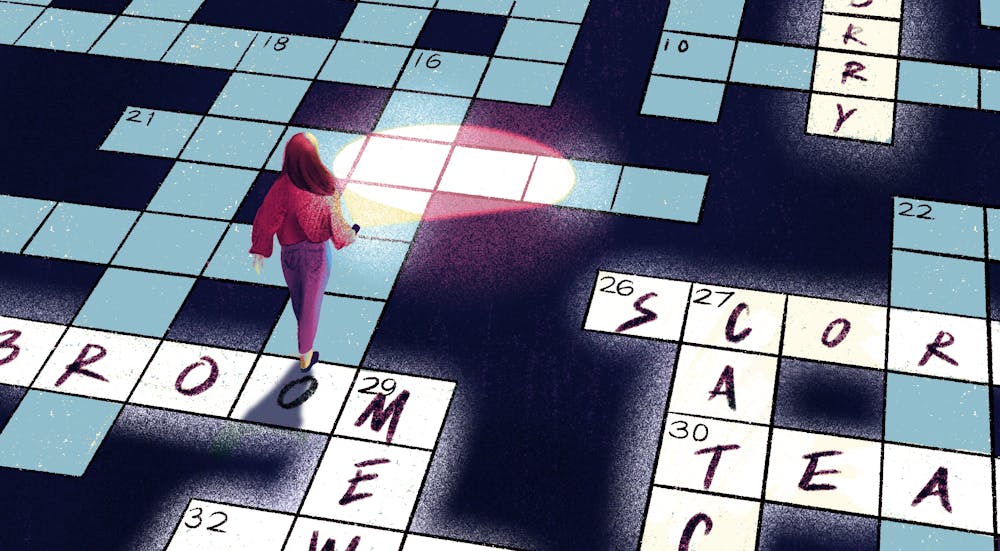As I looked around my afternoon psychology lecture, an overwhelming number of students had their laptops open to crossword puzzles. From The New York Times' daily mini-puzzle to The Wall Street Journal’s Monday puzzle to The Daily Pennsylvanian's acrostic, there seemed to be countless students trying to solve a crossword in between lecture slides. It was surprising to see a shift from the typical lecture hobbies of Instagram, online shopping carts, and texts with friends. Has Gen Z taken up a new hobby?
Crossword puzzles have often been a staple in people’s daily routines. There’s something comforting about using problem-solving skills and critical thinking in an activity with little at stake. These puzzles are a simple way for people to exercise their minds and even distract themselves from the outside world, even if only for a few minutes each day.
Crossword puzzles first emerged in 1913, just as the First World War was beginning. At this time, Arthur Wynne, an editor at the New York World, understood that people needed a simple, fun, and challenging distraction to take their minds away from the unfolding horrors around them. He published the first crossword puzzle and, throughout the war, people turned to this recreational diversion to lift their spirits. Not only did the puzzles offer a break from the harrowing news, but each puzzle taught its readers about the world around them with a unique approach. And so began the cruciverbalist craze.
Crosswords have continued to rise in popularity, especially in the past few years, transforming from an activity that was often associated with older adults to an activity that young people also greatly enjoy. Perhaps this is due to a rise in intellectual curiosity among millennials and Gen Z. Perhaps young people are looking for new ways to challenge themselves and their minds. Or, perhaps crosswords serve as a cool, retro way for people to distract themselves and immerse themselves in something fun and engaging during hard times. Reflecting a growing interest among a younger audience, many crosswords now employ clues that are geared toward youth culture. For example, The New York Times' crossword often uses the clue “rapper Minaj.”
An avid crossworder who also works for the Daily Pennsylvanian crosswords, May Hathaway (C '25), shares that she believes the rise in popularity may be due to The New York Times’ mini crossword puzzle: “It's a really quick and easy habit that anyone can build, and there's also the social element of the leaderboard.” Hathaway and her friends began a new crossword club after they began solving the puzzles as an easy and fun social activity. She noticed that her friends at other colleges had similar clubs, and she was inspired to start a club that focuses exclusively on crossword puzzles. She reflects that “it was easy for us to do the puzzles even when we weren't together, and it was extra fun solving them together because they felt more doable, and everyone has different types of niche knowledge or solving skills that make the entire puzzle easier to solve.”
Hathaway's club at Penn has taken off since she and her friend started it last year. Although there were a few similar clubs focused on word games, Hathaway figured that this club would be niche as “crosswords are a little unique compared to a game like Wordle or Spelling Bee. The club is very much still developing but the main goal is to bring together people who love crosswords so we can solve and possibly construct them together!”
Post–COVID–19, this rise in crossword puzzle activity among Gen Z has been the most dramatic. During Zoom school and endless free hours during the pandemic, teenagers turned to crosswords to distract themselves while also exercising their brains. As opposed to the typical scroll through Instagram, crossword puzzles allow people to truly tune out from the world around them. They also became a point of connection between people like May; friend groups circulated texts about different clues and different daily completion times. Just as those in 1913 needed a quick distraction throughout the day, so too, young people today need to tune in to a new activity to help quiet the world around them for a few moments each day. In fact, there are even many TikTokers who post clips of themselves completing the puzzles. These TikToks show people competing for faster completion times, and their followers excitedly follow along and even join in, seeing how quickly they themselves can complete the puzzles.
While we may not be living through World War I like the first cruciverbalists, Gen Z has certainly gone through its fair share of big challenges. From the pandemic, to international and national conflict, to the mental challenges that arise from the 24/7 nature of social media, it makes sense that members of this generation need a new outlet. Crossword puzzles enable us to be challenged and to think in new and creative ways.
Crosswords can make someone's day better and open their mind to curiousities; they allow people to disconnect from the world around them while exercising their minds, and learning new facts, words, history, and pop culture. For a distraction that’s both productive and interesting, the crossword puzzle may be the solution to that daily malaise you’ve been battling in your own psychology lecture.







